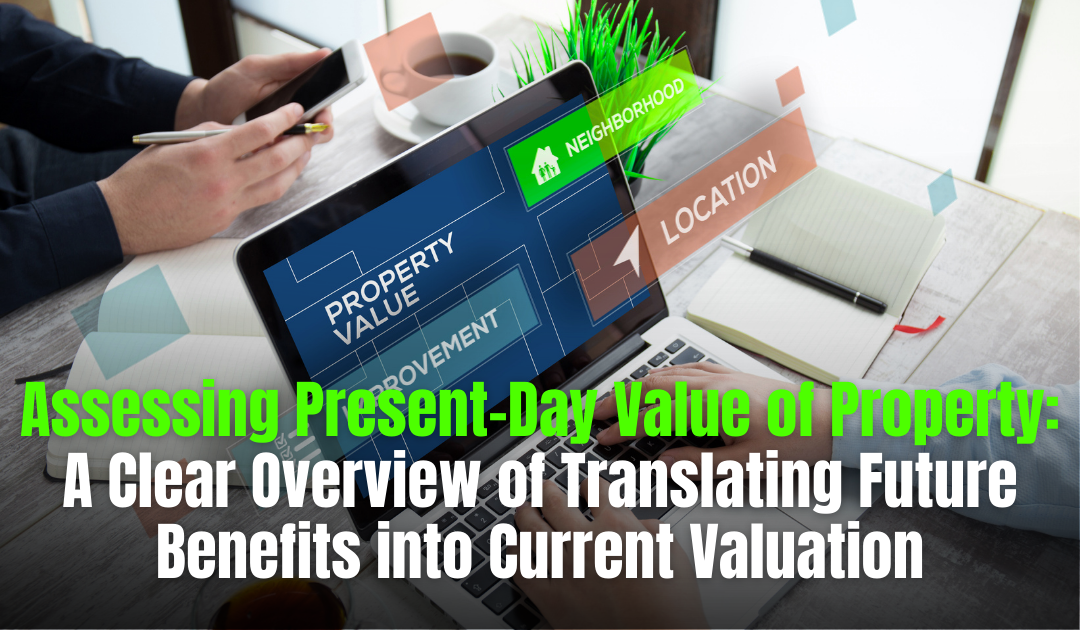Accurately valuing any real estate investment depends largely on how its expected future benefits are converted into today’s monetary terms. This concept—translating future benefits into current valuation—is fundamental to real estate finance, investment analysis, and strategic property decision-making. Whether assessing development potential, rental income, or long-term resale value, understanding the mechanisms behind present-value calculations fosters clearer, more informed judgment.
This article examines the principles behind present-value analysis, walks through its practical application in valuing commercial property, and outlines how professionals ensure these valuations are both precise and credible.
Understanding the Time Value of Money in Property Valuation
Money’s value changes with time. A rupee received today can earn interest or be reinvested, so it’s worth more than the same rupee in the future. Present-value (PV) analysis leverages this principle by discounting future cash flows to their equivalent worth today.
Key elements include:
- Future Cash Flow Estimates
These encompass forecast rental revenues, proceeds from sale, tax benefits, operational savings, or other financial advantages over the ownership period. - Discount Rate
This reflects the opportunity cost of capital, market risks, inflation, and sector-specific uncertainties. Selecting an appropriate rate is essential—too low inflates present value; too high understates it. - Present-Value Formula
A standard approach is:
PV=FV(1+r)nPV = \frac{FV}{(1 + r)^n}PV=(1+r)nFV
where FV is the future amount, r is the discount rate, and n is the number of periods.
This method standardizes future benefits into a net present figure, enabling investors to compare diverse real estate opportunities on a common ground.
Applying Present-Value Analysis to Commercial Property
Valuation of commercial property often spans years or decades—a staggered stream of rental income, varying occupancy, maintenance outflows, and eventual resale value. Present-value analysis brings precision to this complexity.
Steps include:
1. Forecasting Cash Flows
- Rental revenue accounting for vacancies, escalations, and lease renewals
- Operating expenses, including property management, utilities, and taxes
- Capital expenditures for renovations or structural upgrades
- Terminal or exit value when the property is sold at the end of the investment horizon
2. Determining the Discount Rate
This could be based on:
- Risk-free reference (e.g., government bond rate) plus property-specific risk premium
- Market-based yields prevailing in commercial real estate
- Investor return targets like Internal Rate of Return (IRR) expectations
3. Discounting Each Cash Flow
Each projected inflow or outflow is discounted back to its present value and then aggregated.
4. Cross-checking with Market Data
To ensure realism, these PV-based valuations are often compared against market comparables and alternative valuation methods.
Complementing PV with Other Valuation Approaches
Present-value analysis isn’t used in isolation. Valuation professionals typically reconcile it with other respected methodologies:
- Sales Comparison Approach
Value is inferred from recent market transactions of similar properties—useful for benchmarking.
Valuer WorldWikipedia - Cost Approach
The value equals the cost to replace or reproduce improvements minus depreciation, plus land value.
Wikipedia - Income Capitalization Approach
Common in income-generating real estate: property value is calculated by dividing net operating income by a capitalization rate.
Wikipedia
By aligning the PV outcome with these approaches, valuation reports gain credibility and offer stakeholders confidence in decision-making.
Why Rigorous Present-Value Modeling Matters
Let’s consider two scenarios:
A. Investor Decision in Commercial Acquisition
An investor considers buying an office complex expected to generate ₹12 million net rent annually for the next 8 years, with an expected sale of ₹50 million at the end. Applying a chosen discount rate (say 10%), the investor discounts each future cash flow and sale proceeds to estimate the present value. If PV exceeds the asking price, it validates the purchase; if not, the investor may reconsider.
B. Developer Project Feasibility
A developer aims to convert a warehouse into a retail-hospitality complex. Construction spans two years (no income), followed by 10 years of rent, then sale. PV modeling helps assess whether long-term returns merit development and holding costs—critical for strategic decisions.
Enhancing Reliability in Present-Value Calculations
Several factors influence accuracy:
- Realistic Projections
Rental growth assumptions, vacancy rates, and operating costs must rest on credible market research. - Appropriate Discount Rate
Must reflect asset-specific risks and match investor objectives. - Scenario Analysis
Presenting base, optimistic, and conservative projections shows sensitivity and builds transparency. - Structural Legal & Regulatory Checks
In India, valuations must often be performed by registered valuers recognized by the Insolvency and Bankruptcy Board of India (IBBI), ensuring legal compliance and acceptance by courts, banks, and regulatory bodies.
ezyLegal+1valuer.co.in - Use of Certified Valuation Platforms
Trusted networks of certified valuers—such as those working with valuer.co.in—provide due diligence, documentation support, and timely delivery of legally valid reports. Their process typically includes property inspections, data collection, regional sale comparables, and method transparency.
valuer.co.in+1
Regulatory and Professional Framework in India
Valuers in India operate within a structured legal framework:
- IBBI Registration under Section 247 of the Companies Act, 2013 is mandatory for legally recognized valuations.
- Membership in Registered Valuers Organizations (RVOs) ensures adherence to professional standards.
ezyLegal - Institution of Valuers (IOV) also plays a key role in regulating standards, training, and professional guidance.
Wikipedia
These mechanisms safeguard valuation integrity, making PV-based reports more robust and credible.
Final Thoughts
Translating future financial benefits into present-day value lies at the heart of sound real estate valuation—especially for commercial property, where investment timelines are extended, and income streams are layered. Present-value analysis offers clarity, comparability, and precision.
By anchoring projections in realistic assumptions, applying justifiable discount rates, and reconciling with alternative valuation methods, professionals deliver valuations that stakeholders—investors, lenders, developers—can trust.
Supporting these calculations with legal compliance through certified valuers and professional standards ensures not just numerical accuracy but also regulatory and legal soundness.
Ultimately, leveraging present-value methodology equips decision-makers to evaluate properties not just for what they may yield in the future, but for what they truly represent today.


